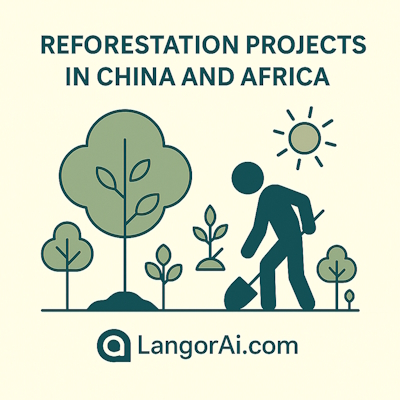
IELTS Reading Practice Test – Passage 1
Reforestation Projects in China and Africa
Large-scale reforestation has emerged as a central strategy to combat climate change, soil erosion, and declining biodiversity across many regions. Two of the most ambitious examples are China’s afforestation programs in its northern provinces and collaborative forest restoration efforts in several African nations. While both initiatives aim to reverse environmental degradation, their contexts, methods, and long-term outcomes vary significantly.
China’s challenges with deforestation stem partly from rapid industrial expansion in the twentieth century. As agricultural land increased and timber demand rose, vast areas of natural forest were cleared. This intensified dust storms and soil loss, particularly across the Gobi Desert’s advancing frontier. In response, the Chinese government launched the “Three-North Shelterbelt Program” in 1978, widely known as the “Great Green Wall,” with the objective of planting billions of trees to slow desertification and create more stable environmental conditions.
The project has relied heavily on fast-growing, single-species plantations, chosen for their low cost and rapid visual impact. While these plantations have successfully reduced wind erosion in many regions, critics argue that monoculture forests lack ecological resilience. Trees in such plantations are more vulnerable to disease, drought, and temperature fluctuations, making long-term sustainability uncertain. For this reason, recent phases of the project emphasize mixed-species plantings and locally adapted varieties.
In contrast, African reforestation efforts are often driven by local community needs. Rather than focusing solely on halting desert expansion, these projects link environmental restoration with food security and income generation. Countries such as Senegal, Ethiopia, and Niger have participated in a continental initiative known as the African Great Green Wall. Unlike the Chinese approach, many African projects incorporate agroforestry, where trees are interplanted with crops, providing shade, improving soil fertility, and offering harvestable products such as fruit or gum resin.
The success of African programs is closely tied to community ownership. Farmers, village councils, and women’s cooperatives often take responsibility for planting, protecting, and harvesting trees. This local engagement strengthens long-term commitment and reduces the risk that newly planted forests will be cut down for fuel or farmland. However, funding remains a major obstacle. Many regions rely on international donors, making their progress sensitive to global economic shifts.
Both China and Africa face climate unpredictability, which complicates reforestation planning. Drought, shifting rainfall patterns, and rising temperatures threaten young trees. In response, scientists have increasingly stressed the need for restoring native vegetation rather than imposing uniform forest designs. Native species tend to be more resilient, support richer wildlife, and regenerate naturally without intensive maintenance.
Despite setbacks, reforestation in both regions has produced visible benefits. Reduced soil erosion, revived wildlife habitats, and greater carbon sequestration have been documented in field studies. Yet experts caution that forests must be understood as dynamic ecosystems, not simply as carbon-storage infrastructure. Sustainable restoration requires patience, scientific guidance, and continuous community engagement.
Questions 1–7 (Yes / No / Not Given)
Questions 8–12 (Matching Information to Paragraphs)
Match the statements (8–12) to the correct paragraph (A–F).
A = Paragraph 1
B = Paragraph 2
C = Paragraph 3
D = Paragraph 4
E = Paragraph 5
F = Paragraph 6
Questions 13–15 (ONE WORD ONLY)
Answer Key & Explanations
1 → NO – Early strategies used monoculture, not biodiversity.
2 → YES – Passage states agricultural expansion contributed to forest loss.
3 → NO – African projects link restoration to income and food, not just desert prevention.
4 → YES – Agroforestry improves soil and provides harvestable goods.
5 → NOT GIVEN – It says funding is partly international, but not “entirely local” or “entirely foreign.”
6 → YES – Climate unpredictability affects survival of young trees.
7 → YES – Native species are described as more resilient.
8 → C – Paragraph 3 discusses vulnerability of monoculture plantations.
9 → E – Paragraph 5 emphasizes community participation.
10 → B – Paragraph 2 explains deforestation drivers in China.
11 → D – Paragraph 4 details the African Great Green Wall.
12 → F – Paragraph 6 stresses native species resilience.
13 → dust
14 → fruit
15 → carbon
• For YES/NO/NG, match *meaning*, not words. If information is not confirmed → NOT GIVEN.
• Matching Information → look for **function** of the paragraph, not single vocabulary matches.
• Short-answer → copy exact words from the passage, avoid plurals.
